Deep sleep, the Winter, cold, wet, and grey; surely all the world is dead, spring is far away?
What is it in us that conjures fairies? Or believes in the greater and lesser supernatural? What is it in us that contemplates a world where a spangled tree might contain dancing dryads or a mountain echo might billow from an actual being (not simply rock-reflected vocals)? It is a child-like self, an imaginative self, or a deep belief that the unknown is vastly greater, larger, and more inhabited than we realize?
"The Fairies are the most numerous, the most beautiful, and the most memorable of the minor supernatural beings" Jose Luis Borges instructs us in his beloved bestiary of imagined creatures ('beloved' because he continued to add to this "out of the way erudition" over twenty years).
Borges continues:
They meddle magically in human affairs and their name is linked to the Latin word, fatum, meaning fate/destiny. They are not restricted to a particular place or a particular period. Ancient Greeks, Eskimos, and Indians all tell stories of heroes who have won the love of these creatures of the imagination. Such fortunes hold their perils. A Fairy, once its whim is satisfied, may deal death to its lovers.
Fairies also have a more ominous side that is luring children, confusing, sailors, and spiriting away anyone who learns their secrets. And yet, we guess their secrets: love of nature, a bit impish, protective, a spec of industry.
I abide by fairies and other such things so we are not the only cognizant stewards of the world. The idea that fairies exist to tend flowers and trees makes me joyful even though this joy never departs an imagined realm.
The Song of the Snowdrop Fairy
Deep sleeps the Winter,
Cold, wet, and grey;
Surely all the world is dead;
Spring is far away.
Wait! the world shall waken;
It is not dead, for lo,
The Fair Maids of February
Stand in the Snow!
Reading these lovely century-old lines from Cicely Mary Barker (June 28, 1895 - February 16, 1973) I wonder if perhaps our mental propagation of fairies is not from needing answers to questions like "Why do snowdrops bloom in snow" but rather, what is the nature of beauty unknown to us? Is that a fairy spirit?
The Song of the Yew Fairy
Deep sleeps the Winter,
Cold, wet, and grey;
Surely all the world is dead;
Spring is far away.
Wait! the world shall waken;
It is not dead, for lo,
The Fair Maids of February
Stand in the Snow!
Barker's Fairy Flowers, a series of post and greeting cards alighted on popular culture (Queen Mary was a patron) during the modern reimagining of fairies owing to J. M. Barrie's Peter Pan and Wendy in 1904 and the 1918 Cottingley Fairies of West Yorkshire, a series of faked photographs that inspired many to believe in the improbable existence of fairies.
After Barker died in 1973 her works were divided among seasonal reprints including Flower Fairies of Winter. Her beautiful illustrations deliver a dream-like memory of childhood, a spark in the wood, a side-eye-caught movement in the grass.
 The Hazel-Catkin Fairy.
The Hazel-Catkin Fairy.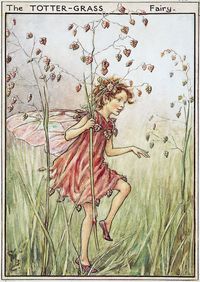 The Totter-Grass Fairy.
The Totter-Grass Fairy. The Yew Fairy.
The Yew Fairy.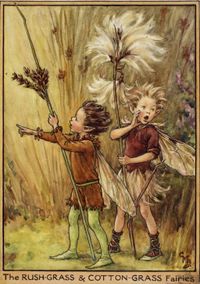 The Rush Grass and Cotton Grass Fairies.
The Rush Grass and Cotton Grass Fairies.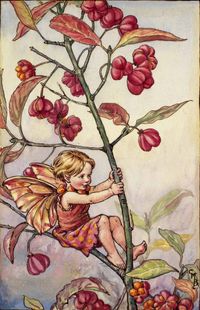 The Spindle Berry Fairy.
The Spindle Berry Fairy.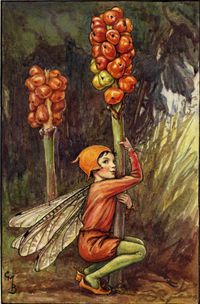 The Lords and Ladies Fairy.
The Lords and Ladies Fairy. The Plane Tree Fairy.
The Plane Tree Fairy.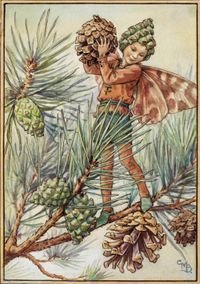 The Pine Tree Fairy.
The Pine Tree Fairy.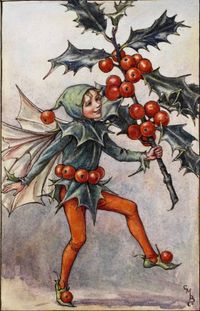 The Holly Berry Fairy.
The Holly Berry Fairy. The Box Tree Fairy.
The Box Tree Fairy.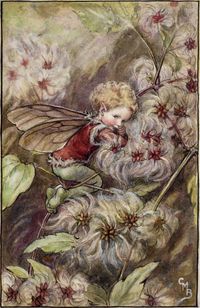 The Old Man's Beard Fairy.
The Old Man's Beard Fairy.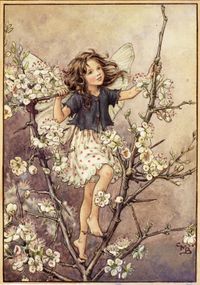 The Blackthorn Fairy.
The Blackthorn Fairy.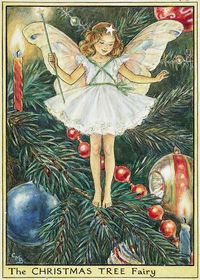 The Christmas Tree Fairy.
The Christmas Tree Fairy.My favorite is the Lords-and-Ladies Fairy in which Barker includes a note to the bearer that the berries of this Wild Arum - quite poisonous - are not to be eaten. Reminds us of little intrepid readers and foragers who would be reading her books, and might be so entranced.
The Song of the Lords-And-Ladies Fairy
Fairies, when you lose your way,
From the dance returning,
In the darkest undergrowth
See my candles burning!
These shall make the pathway plain
Homeward to your beds again.
(These are the berries of the Wild Arum, which has many other names and has a flower-like hood in the Spring. The berries are not to be eaten.)
Who else might have privately summoned fairies and kept them in pockets of imagination? Surely those traipsing the nearest reachable magic of the world like Romantic poet John Clare or George Burrow's foot-by-foot observations of the Welsh country. Or those whose imaginations abound to the supernatural like Edward Gorey's relentless creature and Kawanabe Kyōsai's 100 demons. Borge's bestiary of all beasts imagined (or as many as he could figure in twenty years) is more than a catalog, it is a celebration of those who believed in them.

